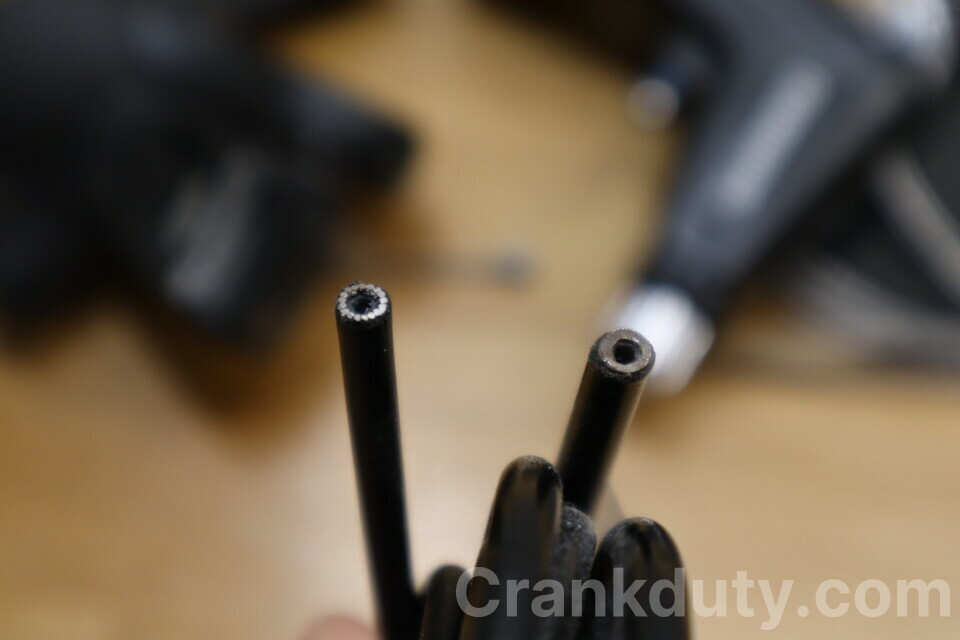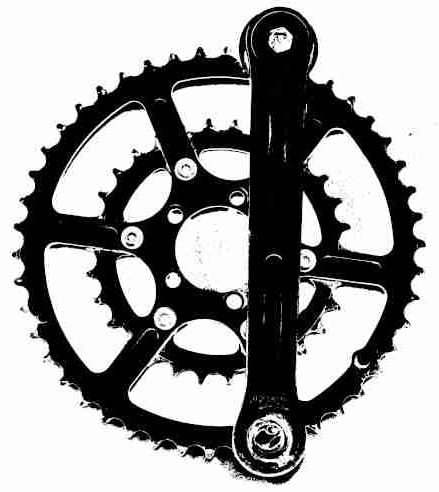Brake vs. Shifter Cable and Housing – Do They Mix?
Bicycle brake and shifter (gears) cables look very similar – and so do the cable housings. This raises two questions: (1) How to tell brake and shifter cables and housings apart? (2) Can you mix&match? I wrote this article to clear the confusion around this topic.
The short answer is that brake cable&housing are thicker than shifter cable&housing and also of different construction. Brake and shifter cables and housings are not cross-compatible except in rare cases; some combinations can even be dangerous.
Next we will take a more detailed look into the two cable types. You will see why you want to use brake cable for brakes and shifter cable for gears.

Brake vs. Shifter cable
Brake and shifter cable are mostly not cross-compatible despite similar looks. They differ in thickness, head shape, cross section and supplied lengths.
1 Thickness
Brake cable is noticeably thicker than shifter cable. The typical thicknesses of brake cable are 1.5 and 1.6 mm, while shifter cable is usually either 1.1 or 1.2 mm.
This means that shifter cable is weaker than brake cable – but also more flexible, and bends easier to
2 Head shape
Brake cables have either a large cylindrical head lug cross-wise to cable (MTB) or a mushroom-shaped lug along the cable (road). Shifter cables by contrast have a slighly smaller cylindrical lug that is oriented along the cable.
3 Cross-section
Both brake and shifter cable have a twisted wires in the surface. But shifter cables often have a few “hidden” details in the cross section for shifting performance: (1) a straight-wire core for improved stiffness (2) smooth-ground surface for lower friction.
4 Length
Shifter cables come in slightly longer (uncut) lengths than brake cables to cover the longer cable path to the rear derailleur. Typical shifter cable lengths are 2100 mm, 2300 mm or higher for special models (tandem). Brake cables are 1750 mm or 2050 mm as standard.
| BRAKE VS SHIFTER CABLE | BRAKE cable | SHIFTER cable |
|---|---|---|
| Thickness: | 1.5/1.6 mm | 1.1/1.2 mm |
| Head shape: | cylinder across (MTB); mushroom (road) | cylinder lengthwise |
| Lengths: | 1750…2050 mm | 2100/2300mm, longer |
| Material: | carbon steel, stainless steel | carbon steel, stainless steel |
| Cross-section: | twisted wire | twisted/ straight wire (opt) |
| Finishing: | plain | surface-ground pre-stretched |
Can you use brake cable for shifter?
No – a brake cable does not work in the shifter. The brake cable too thick for the shifter cable housing and the head is too big for the shifter. The cable is also to stiff to bend nicely in the tighter curves inside the shift levers.
Can you use shifter cable for brakes?
Yes – you can use shifter cable with many brakes, but the cable will not last long.
The smaller cross section of the shifter cable means that the stress in the cable wires is substantially higher (~2x). This will lead to a cable failure much sooner than with a proper brake cable.
Brake vs. Shifter housing
Brake and shifter cable housings are also different, despite nearly identical appearance. They are not cross-compatible for the most part.

Brake housing
Brake housing has an outer diameter of 5 mm and takes in the thicker 1.5…1.6 mm cable. Like shifter housing, brake housing has a plastic sheath (often black) on the outside. Inside, brake housing has a spiral-wound steel layer. Brake cable may or may not have an inner plastic lining between the steel spiral and the cable to reduce friction.
The brake housing construction is strong and relatively flexible (given its diameter). It is stiff enough in compression for brakes and friction shifting, but not for indexed shifting.
Shifter housing
Shifter housing is 4 mm OD and has an ID that just fits the 1.1…1.2 mm shifter cable. On the outside, shifter housing has a plastic sheath (just like brake), but inside it is an annulus of straight steel wires as the load-carrying layer. On the very inside, shifter housing has a lining of PTFE (Teflon) or other low-friction material.
The construction of shifter housing is often called compressionless, and is much stiffer (in compression, not bending) than the brake housing. The added stiffness is needed for reliable indexed shifting.
Can you use shifter housing for brakes?
No – shifter housing will not work for brakes. The main reason is that the thicker 1.5…1.6 mm brake cable will not fit properly into the shifter housing.
In principle, you could use thinner shifter cable with the shifter housing for brakes. But this is not recommended: the shifter housing may burst under the larger braking forces. The housing has high initial stiffness, but its cross section is not very strong. If there is too much compression, the straight-wire annulus may buckle outwards and the housing loses all of its stiffness.
Can you use brake housing for shifters?
No – you cannot use brake housing for modern indexed shifters (but you could use it for old friction shifters).
The thinner shifter cable fits brake housings without a problem. But compression is the problem: the spiral-wound structure of the housing makes it too spongy for reliable indexed shifting. Shifting must be precise to the millimeter or less – this is only 1/2000th (0.05%) of the rear derailleur housing length. Changing tension in the cable – i.e. compression in the housing – should not cause even 0.05% length change.
However, older friction shifters (often downtube) would work even with brake housing. You swing these shifter levers until you get to the gear you want. In the process, you end up adjusting for any compression in the housing.



